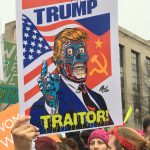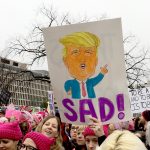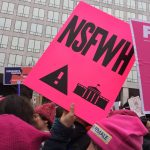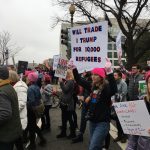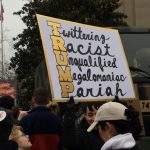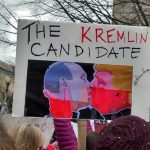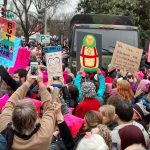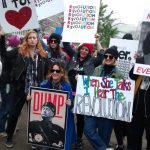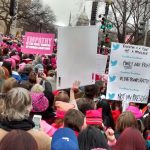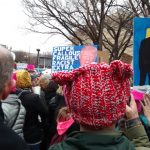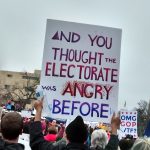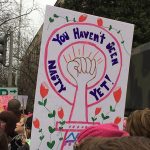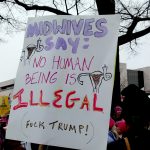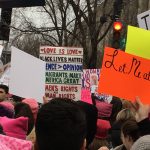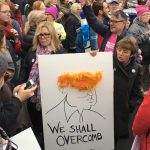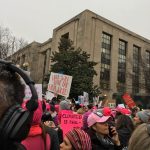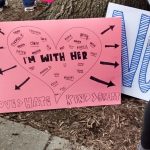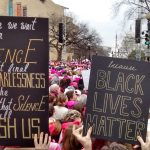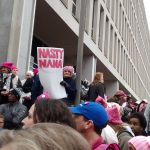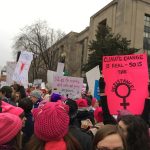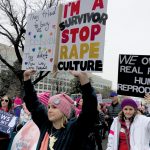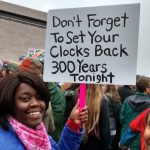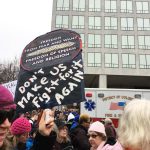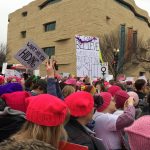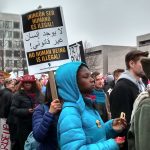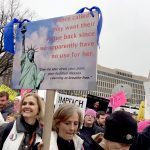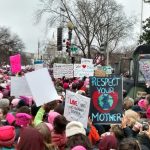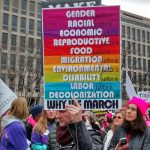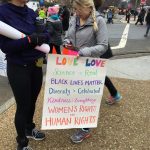Anger, Profanity, and Hatred
In the U.S., 2017 ushered in a new presidential administration and a new era of protests. On January 20, approximately 160,000 people attended the inauguration ceremonies of now-President Donald J. Trump in Washington, D.C. The following day, roughly three times as many gathered in the same location to denounce this new president and his administration’s political values.
The Women’s March was the largest one-day protest event in history. An estimated 500,000 men, women, and children participated in the Women’s March in Washington, D.C., and another 4.2 million participated in more than 670 sister marches held around the world, on every continent including Antarctica. The world voiced its objections to the inauguration.
Many of the Washington, D.C. participants wore pink “pussy hats” to show solidarity within the crowd and with others who were unable to attend. To punctuate their concerns, they carried banners, adorned their clothing with messages, and brandished posters. These posters were not carried in the orderly fashion of the Suffrage Movement marches. Nor did they have the unified message of the Memphis sanitation workers. But they had the optics of a population on fire. Optimistic, peaceful, and hopeful pleas were few. Emphatic messages of anger, disbelief, and alarm were many. Yet what might be perceived as a cacophony of messages found its resonance as collective anti-Trump rancor.
By studying these messages, beyond finding exemplars of “protest porn,” we can more clearly understand the issues and concerns that animated millions of individuals to participate in this historic protest. Posters create a flexible, class-free mechanism for a multitude of expressions, both visual and semantic. These messages can be conveyed on fine-quality linen, store-bought poster-board, or recycled hunks of cardboard. They can be printed via high-quality presses or created by hand and the materials needed to make them are inexpensive and readily accessible. Precision and professional craftsmanship can be effective, but are not required for a potent design. An unrefined visual message can convey an effective emotional statement, as with roughly drawn letters to indicate anger. With this, protest signage can give a visual representation and validation of invisible thoughts and emotions. From the professionally designed to the hastily collaged, these messages received media coverage during the Women’s March.
Many marchers carried mass-produced messages from Planned Parenthood, NOW, media outlets, and others, but the handcrafted posters packed more punch with their “screaming” uppercase letters; generous use of warm, agitated colors such as reds and oranges; liberal use of exclamation points and emphatic underlining; and NSFW language and imagery.
Some made simple but pointed messages. One poster (not pictured here), had a minimalist design: In the center of a three-foot-by-two-foot poster board was what looked to be a pile of fecal matter in the shape of a head, approximately one-foot in diameter. Strategically placed on top of this round shape was an orange-blond toupee. The poster edges were wrapped in bright pink duct tape. Without a single word, its message was bold and blunt.
These posters reflect the cultural zeitgeist, leveraging concepts such as “snowflakes,” being “nasty,” and what it means to “fight like a girl”; pop culture references to Hamilton and Beyoncé lyrics, Hermione, and recently deceased Carrie Fisher’s Princess Leia; and the language of the moment: “stay woke,” “feminist AF,” and “bigly.”
The last U.S. Presidential election and its aftermath seem to affirm Georg Simmel’s ideas about conflict: it helps individuals define their differences, establish to which group(s) they belong, and determine the degrees to which groups are different from each other. The election aftermath has achieved that and then some. The political concerns represented at the Women’s March would reverberate in protest events throughout the year, including the Native People’s March on Washington, the March for Science, the March for Climate Change, the Tax March, National Pride March, and the March for Racial Justice, among others. The posters protesters carry mirror our country’s divisiveness, emotions, and intentions as we head into the second year of Trump’s presidency.
First and foremost, posters expressed hatred for, disagreement with, and mockery of Trump, often using his own words and Tweets against him.
Some participants used their posters to address election issues including Russia’s tampering, Trump’s referencing the size of his hands, and Trump’s “hot mic” moment from 2005 in which he bragged about sexually assaulting women.
As these posters indicate, emotions were running high. Women’s March participants did not hold back their anger, frustration, sadness, disgust, despair, displeasure, and hatred toward the new administration. The posters were notable in their liberal use of profanity. For example, protesters also carried posters in the March for Racial Justice (M4RJ) held in September 2017. The weekend before this event, Trump first disparaged NFL players who knelt during the National Anthem. Although the M4RJ protesters naturally offered passionate arguments, their messages lacked the rawness and vulgarity of the Women’s March posters and only a few incorporated curse words, almost all of which were directed at Trump.
Along with the anger came fleeting instances of humor and optimism. Some poked fun of Trump, while others offered more peaceful, less confrontational messages of solidarity.
The signage predicted many of the hot-button issues this administration would face: immigration, climate change, international war, Planned Parenthood funding, legitimization of the news media, the Affordable Care Act, Russian President Vladimir Putin’s role in the U.S. presidential election, and general resistance overall.
Poster-makers also connected their messages to their identity and sense of self. Some signs carried rebuttals to being called “Snowflakes,” Trump supporters’ derogatory terms for Clinton supporters, while others advocated from first-person perspectives, as with this rape survivor’s sign.
Many protesters connected their concerns to previous protests, historical events, and social movements. A small number of protesters dressed as Suffragettes wearing early 1900s-style dresses and sashes with slogans such as “Rights for Women.”
Single issues were addressed with a range of arguments and perspectives. Regarding Trump’s stance on immigration, for example, protesters leveraged ideas of boarder walls, how restricting immigration would defy the core concept of the Statue of Liberty, and how no human being should be considered illegal.
What might be considered as a gender-focused event was actually a sort of rally for intersectional concerns. Individuals often carried posters that addressed concerns on a variety of issues.
